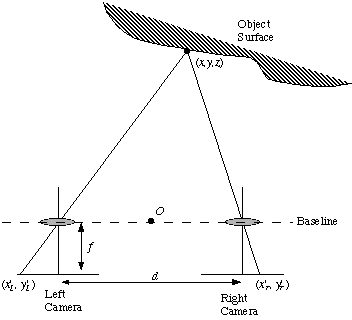
Let us consider a simplified approach to the mathematics of the problem in order to aid understanding of the tasks involved.
We will consider a set up using two cameras in stereo. -- other methods that involve stereo are similar.
Let's consider a simplified optical set up:
Fig. 5 A simplified stereo imaging system
Fig. 5 shows:
Consider a point (x,y,z), in three-dimensional world coordinates, on an object.
Let this point have image coordinates
![]() and
and ![]() in
the left and right image planes of the respective cameras.
in
the left and right image planes of the respective cameras.
Let f be the focal length of both cameras, the
perpendicular distance between the lens centre and the image
plane. Then by similar triangles:

Solving for (x,y,z) gives:

The quantity ![]() which appears in each of
the above equations is called the disparity.
which appears in each of
the above equations is called the disparity.
There are several practical problems with this set up:
However as the camera separation becomes large difficulties arise in correlating the two camera images.
In order to measure the depth of a point it must be visible to both cameras and we must also be able to identify this point in both images.
As the camera separation increases so do the differences in the scene as recorded by each camera.
Thus it becomes increasingly difficult to match corresponding points in the images.
This problem is known as the stereo correspondence problem.